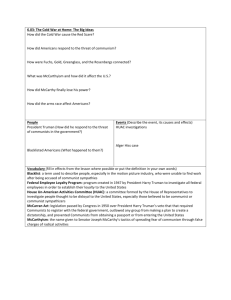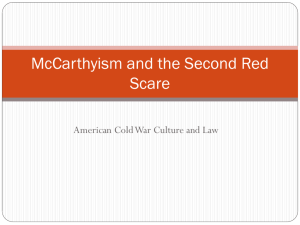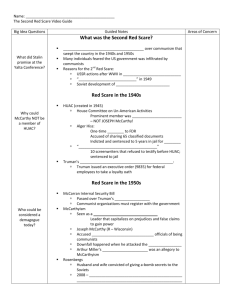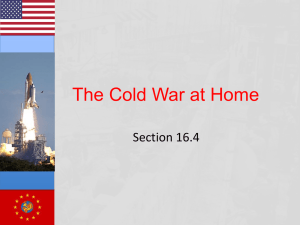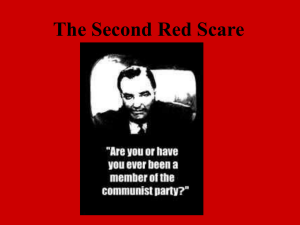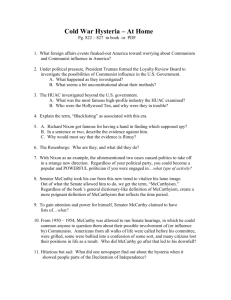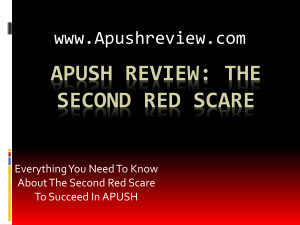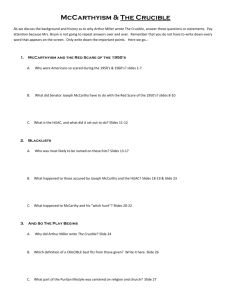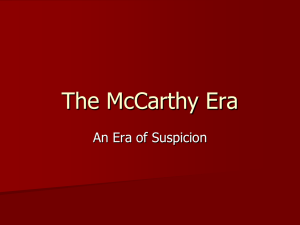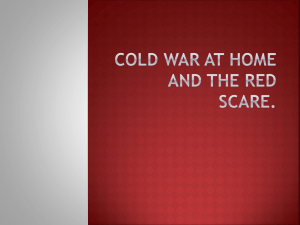Unit 5 Chapter 3 The 2nd Red Scare and McCarthyism Power Point
advertisement
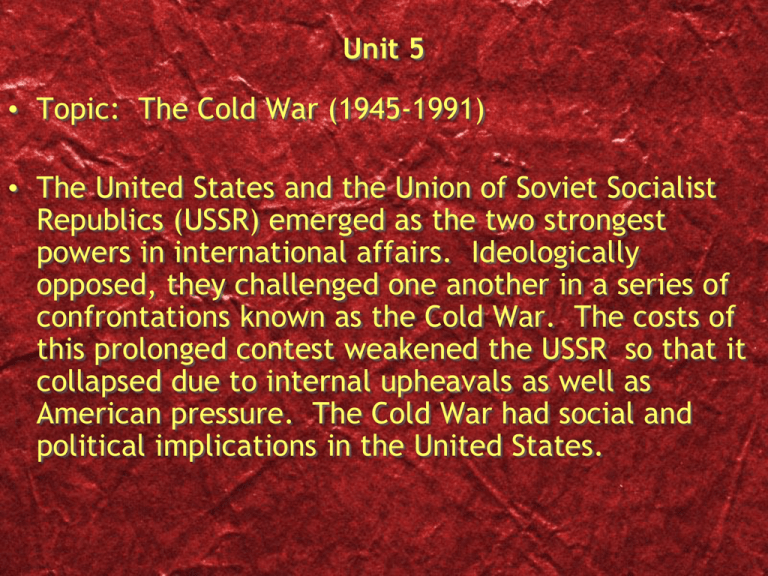
Unit 5 • Topic: The Cold War (1945-1991) • The United States and the Union of Soviet Socialist Republics (USSR) emerged as the two strongest powers in international affairs. Ideologically opposed, they challenged one another in a series of confrontations known as the Cold War. The costs of this prolonged contest weakened the USSR so that it collapsed due to internal upheavals as well as American pressure. The Cold War had social and political implications in the United States. Chapter 3: The 2nd Red Scare and McCarthyism • Content Statement: The Second Red Scare and McCarthyism reflected Cold War fears in American society. • Expectations for Learning: Explain how the Second Red Scare and McCarthyism reflected Cold War fears in American society. Section 1: Second Red Scare • Content Elaboration: The actions of the Soviet Union in Eastern Europe and the spread of communism in Asia sparked fears among many Americans. A second Red Scare focused attention on the media, labor unions, universities and other organizations as targets of communist subversion. • Like the first Red Scare following World War I, civil liberties were again challenged. The investigations of the House Un-American Activities Committee (HUAC) prompted emplyers to blacklist suspected communists, including actors and writers. 2nd Red Scare • A. The second red scare—fear of communism • 1. Russians detonate atomic bomb (1949) and China becomes Communist (1949) • 2. Possible Communist spies in Canada • 3. Truman: • a. millions of federal employees questioned • b. organizations investigated and 200 fired • 4. Reputations destroyed • a. black lists (HUAC) 2nd Red Scare, cont. • B. Protecting the United States • 1. McCarran Internal Security Act • a. Communist groups had to register with AG • b. Truman vetoes • c. Congress overrides • 2. McCarran-Walter Act • a. immigration quotas • b. favor N and E Europe • c. Truman vetoes • d. Congress overrides • 3. Julius and Ethel Rosenberg • a. suspected in passing atomic secrets to SU • b. Executed--no proof • (Like Sacco and Vanzetti in the 1920’s) Julius and Ethel Rosenberg HUAC • House Un-American Committee • Read the link below: • http://www.history.com/topics/coldwar/huac OGT Multiple Choice • The fear of communism in the United States during the 1950’s was know as the • A. 2nd Red Scare • B. 2nd Yellow Scare • C. 2nd Green Scare • D. 2nd Blue Scare Section 2: McCarthyism • Content Elaboration: Senator Joseph McCarthy played on fears of subversion with his charges of communists infiltrating the U.S. government. The McCarthy hearings ond HUAC investigations held the attention of the American people through the middle 1950s. Joseph McCarthy • A. Joseph McCarthy--R-Wisconsin • 1. Accused many in US gov. of bei ng Communist • 2. BIG LIST--Feb. 1950 • 3. many feared him Joseph McCarthy, cont. • The fall of McCarthy (Picture on page 737) • A. McCarthy goes too far • 1. takes books out of libraries • 2. accuses Secretary of Army of espionage • 3. accuses army officer of protecting coms. • B. Televison • 1. hearings were televised--20 million watched • 2. McCarthy was rude • 3. Looked like a bully • 4. people began to dislike him • 5. his influence declined QuickTime™ and a TIFF (Uncompressed) decompressor are needed to see this picture. QuickTime™ and a TIFF (Uncompressed) decompressor are needed to see this picture. OGT Multiple Choice • A Senator from Wisconsin who started accusing many people of being Communist and then put those names on a “Black List” was • A. Harry S Truman • B. Julius Rosenberg • C. Joseph McCarthy • D. Alger Hiss OGT Multiple Choice • • • • • (Practice Test Booklet 2005) McCarthyism during the early 1950’s was a result of American A. reaction to the reforms of the New Deal B. response to helping win World War II C. fear of African-Americans gaining civil rights • D. fear of communism during the Cold War OGT Multiple Choice • Which of the following events helped cause McCarthy’s fall from power? • A. Eisenhower’s farewell address • B. the Army-McCarthy hearings that were televised to 20 million people • C. Life magazines “Crisis In America” issue • D. the Supreme Court decision in Brown vs. Board of Education
